The Institute of Ecumenical Studies is one of the 9 Institutes created within the Ukrainian Catholic University. 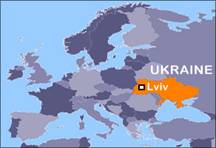
- I. The Ukrainian Catholic University
- II. The city of Lviv a.k.a. Lvov
- III. Lviv within Ukraine
I. The Ukrainian Catholic University
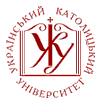
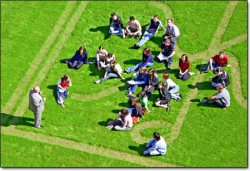
The frame recalls the Royal Gates of an iconostas, the symbol of the Resurrection of Christ. The open book symbolizes the constant search for the truth and the desire for scholarly discovery. The ligature of letters captures the style of medieval universities. The competition for the new emblem was won by the distinguished Lviv artist Volodymyr Kaufman.
On June 29, 2002, the ceremonial inauguration of the Ukrainian Catholic University (UCU) was held in Lviv, Ukraine. UCU is the first Catholic university to open on the territory of the former Soviet Union and also the first university opened by one of the Eastern Catholic churches.
Ukrainian Catholic leaders throughout the 20th century dreamed of the opening of such a university, and, while he was in Lviv on June 26, 2001, Pope John Paul II blessed the future university's cornerstone.
UCU is being founded on the basis of the Lviv Theological Academy, the educational and scholarly institution that has become a center of intellectual and spiritual life for the Ukrainian Greek Catholic Church.
The model of a full-fledged university education was not able to develop in the former USSR, primarily because the totalitarian system would not allow the free development of human thought. Departments of the humanities were forced to serve the reigning ideology. With the collapse of the communist system, the humanities departments of many universities began to expand the field of their work.
The opening of UCU, with its new approach to learning, with the only university-level faculty of theology and 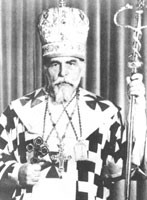 philosophy and the largest modern humanities library in Ukraine (which includes a fund of 20 000 references in English) , is a major step in the effort to change higher education in Ukraine. Because UCU is not a government institution, it has wider possibilities to innovate and to aid in the push for the general reform of university education.
philosophy and the largest modern humanities library in Ukraine (which includes a fund of 20 000 references in English) , is a major step in the effort to change higher education in Ukraine. Because UCU is not a government institution, it has wider possibilities to innovate and to aid in the push for the general reform of university education.
"I consider this project one of the most successful in the field of Ukrainian education, says Vyacheslav Bryukhovetskyy, President of the National University of Kyiv-Mohyla Academy, who has been carefully following the establishment of the Lviv Theological Academy and its transformation into the Ukrainian Catholic University, "I'm impressed by the persistence, consistency, high intellectual standards and clear spiritual vision of the University's leaders. Our nation is now in need of a purification of the soul, a return to Christian ideals. It is simply impossible to overestimate the meaning of UCU here. Above all it will further raise the quality of academic and formational processes by creating a harmonious environment for the development of young people. And this will inevitably yield fruitful results."
“Ukrainian Catholic University — every word here has deep significance,” says Rev. Borys Gudziak (Ph.D. Harvard), Rector of the new university. “The scholarly dimension is indicated by the word ‘university,' a responsible, creative and critical search and use of knowledge.
“The word ‘Catholic' reveals UCU's religious dimension, the openness of the human being to transcendent and interpersonal dialogue. The Christian identity of the university, while rooted in the Eastern tradition, develops in constant dialogue with other people of faith and goodwill.
“Our cultural and social dimensions,” Fr. Gudziak continues, “are found in the word ‘Ukrainian,' the reality that surrounds us; this is who we are. So our task is to be a center for cultural thought and the formation of the new Ukrainian society based on human dignity.”
A prototype Ukrainian Catholic University was established in Rome by Patriarch Josyf Slipyj, head of the UGCC (1944-84). Patriarch Josyf was exiled from Ukraine in 1963, after 18 years in Soviet work camps. In the 1970s and 1980s, he inspired Ukrainian seminarians with the dream of returning to Ukraine to create a fully developed university there.
In 1994, thanks in part to the efforts of graduates of the program in Rome, the Lviv Theological Academy (LTA) was established in Ukraine as the first stage in the development of UCU. The accreditation of the LTA's bachelor's program in theology by the Congregation for Catholic Education in 1998, and the opening of a history faculty and graduate program in theology in 2001 were the most recent steps in UCU's development.
II. The City of Lviv a.k.a. Lvov
Lviv, Lwow, Lvov, Lemberg, Leopolis... it's a city of many faces. Don't expect the pristine perfection of Prague, but nor the millions of tourists for that matter. What you can expect is a dash of magic, as Lviv can hold its own with the most beautiful of Europe's cities. This dreamy metropolis has been both the capital of Habsburg Galicia, and a key city in the Polish-Lithuanian Commonwealth. Today it's Ukraine's sweeping second city. The people are full of spirit, there's a banquet for culture vultures and the architecture can hardly fail to bowl you over. Lviv is on the crest of major change in the wake of Ukraine's Orange Revolution. Visa requirements have already been relaxed for the Summer of 2005, a pattern that looks set to continue as Ukraine strengthens its bid to join the EU.
The 'Lion City'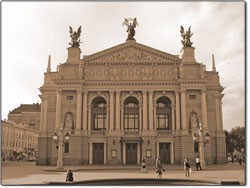
It's said that when the stone lions that stud the city notice a young maiden strolling by, the mighty beasts let out a roar. However, being distinctly cultured fellows, they roar in a fashion which we humans cannot perceive. Travellers with a lion's appetite for culture will be pleased to hear that you won't have to look far to find treasures in Lviv. Simply walking the streets is a pleasure, whilst you could spend several days exploring the delights of the Old Market Square alone. In amongst all these grand old buildings are some tremendous museums. You can savour everything from priceless religious icons in a fine old mansion to the gothic charms of a three hundred year-old (and still functioning) chemists. Meanwhile, Lviv's Gallery of Painting boasts an array of Central and Eastern European art that can put the collections of many better known cities to shame. Musical wayfarers too, will find treats in store. Besides the odd classical performance in one of the city's ancient churches, there's a sublime opera house on hand. At various times of year the romantic old opera house gets involved in Lviv's musical festivals. Last but not least, film buffs may not be able to resist a trip to one of Lviv's eccentric old cinemas, which may have you feeling like you've become a character in a film yourself. For tips on culture , travel and general info follow the links on http://www.lviv-life.com.
MONEY
Ukraine's national currency is Hryvnia (UAH), which currently is equal to about EUR 6.00. You can exchange foreign currency for Hryvnias at many exchange points located throughout the city. Credit cards are becoming much more widely used in Ukraine and most local hotels such as the Grand Hotel and restaurants now accept them here.
CLIMATE
Climate here is moderate continental. January –4 C (26.6 F) / June +18 C (64.9 F)
III. LVIV WITHIN UKRAINE
The history of this country is a complex one, yet in Western Ukraine at least, the hallmarks of a rich European heritage are plain to see, and it is in Lviv that one finds the best reflection of this.
A rich European heritage
Contrary to supposition, Lviv was never governed from Moscow until as late as 1939, a year when Soviet troops marched into the city. Up until this period the reins of power were divided mainly between the Poles and the Austrians, whilst the most remarkable aspect of the city's population was its diversity. This cosmopolitan legacy stretches all the way back to the medieval era, when Italians, Germans, Armenians, Greeks, Jews, Scots, Englishmen as well as Poles and Ruthenians (Ukrainians) all settled in the city. Up until 1939, Lviv boasted three thriving cathedrals: Roman Catholic (mainly Polish), Greek Catholic (mainly Ukrainian) and Armenian Catholic, as well as a number of imposing synagogues and smaller houses of worship.
The Lion City takes its name from Prince Lev of Halychyna, whose descendants died out in 1340, after which the region came under Polish rule. A key factor during this era was the city's treasured 'right of emporium'. Lviv (Lwow in Polish) was perfectly poised to take advantage of the trade between east and west, and the privileges of 1379 boosted the city's stature as a lynch-pin on the Baltic and Black Sea routes. All merchants passing through the region were obliged to stop for two weeks in Lviv, thus giving the city immense powers.
Lviv was ravaged by fire many times over the years, whilst Turks and Tatars became the most persistent military foe, and, to a lesser extent, Cossacks. However, for several generations the city and its mixed population managed to bounce back. Following the raids of the mid-seventeenth century the city was given the rare distinction of being ennobled (1657). 'We desire' records the Royal diploma, 'to confer fresh honour on the city of Lwow and its burghers, subjects of us and of the Republic, subjects of Catholic, Armenian and Greek faith...' It was during this period that the motto Semper Fidelis (Always Faithful) came into being.
From the Habsburg Empire to the Ukrainian Republic
However, the decline of the Commonweath of Poland-Lithuania had begun to set in. Later attempts at reform only speeded the country's demise, as Russia, Austria and Prussia were not well-disposed towards the idea of a revived Poland. Lviv fell to Austria during the first partition of Poland in 1772, and, besides the briefest of changes in 1809, when Napoleon's Polish forces seized the city, Lviv and much of the surrounding region remained a part of the Habsburg Empire until 1918.
Lviv (now renamed Lemberg), became the capital of the Austrian province of Galicia. When Austrian power disintegrated at the close of the Second World War, the Ruthenians seized control of a number of key enterprises and declared a Ukrainian Republic. The Poles fought back and a tragic battle commenced. At this time, most able-bodied men were away on military service, and thus it was largely teenagers who took part in the fighting on both sides. Aided by reinforcements, the Poles eventually won, but the conflict left a terrible bitterness between the two communities.
The Great Powers sanctioned a reborn Poland after the Great War, but the Ukrainians had no such luck. Lviv, now called Lwow again, became an important city in the new Poland. The Soviets invaded Poland in September 1939, in tandem with the Nazis from the West and then held Lviv for two years . D eportations of the intelligentsia began alongside nationalizations of businesses.
The Western allies had consented to Stalin's wish that Poland's border be moved West in 1945, and Lviv became a part of the Soviet Union. Most Poles were compelled to emigrate to cities in the New Poland. Western Ukraine was joined to the so-called Ukrainian Soviet Republic (formed in 1917) whose capital was Kiev. However, as a part of the Soviet Union, this nominal Republic was on a tight leash. The Ukrainian language itself was banned and churches were closed. Throughout the Soviet era, only one house of worship remained open in Lviv, the Roman Catholic Cathedral.
All the same, the city became an important bastion of resistance to russification, and the Ukrainian language itself was kept very much alive within the family orbit, if not in the workplace. When the Soviet Union began to fragment in the wake of the fall of the Berlin Wall, Lviv emerged as one of the champions of Ukrainian independence, which was declared on August 24th 1991.
Travel between Poland and Ukraine had been extremely difficult during the Soviet era. But Polish-Ukrainian relations were marked by their increasingly positive nature, a state of affairs that was strengthened with the coming of President Viktor Yushchenko. Poland's President, Aleksander Kwasniewski, had been a strong supporter of Yushchenko during the Orange Revolution, as it was dubbed. Following the latter's election, the two leaders endeavoured to lay old ghosts to rest, as was symbolised by events such as the re-opening of the Orlat (Young Eagles Cemetery) in June 2005. The same month, senior members of the Polish and Ukrainian clergies proclaimed a reciprocal forgiveness for the countries previous animosities.
Future visitors of the IES will find more useful information on UCU Visitors Page.
Visa information
About Lviv
